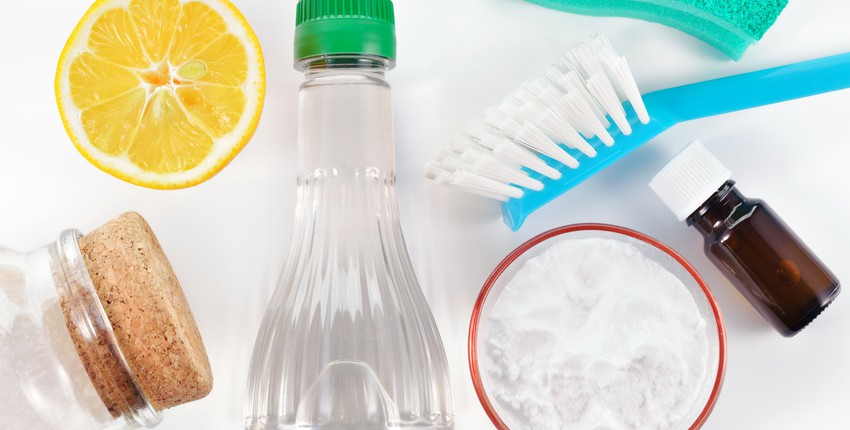
Clean Green for Total Recovery!
We are living in an increasingly toxic world. Even if we improve our nutrition, heal our GI tracts and support our livers, we’re still exposed to over 80,000 chemicals in the surrounding environment. All environmental toxins are inflammatory. Even low doses of toxins can trigger your immune system and result in inflammatory and autoimmune reactions. From heavy metals, petrochemicals, endocrine disrupting compounds (EDCs), herbicides, fungicides and pesticides, to volatile organic compounds (VOCs) and substances found in most commercial and home cleaning products; there is literally no end to the exposures we face. Many of them come from products that are legal, and are even mass-marketed as “safe and beneficial.”
Reduce your exposure for better health!
There is a lot you can do to reduce your exposure, simply by sticking to choices that keep harmful chemicals out of your home and body wherever possible. While you may not be in control of what’s in the environment outside your home, you are in control of what you bring into it. The first step is to learn more about what’s in the products you use every day. The second step is to make sure you’re eliminating the ones that could harm you.
There are healthier alternatives to just about every chemical solution you have in your home, office and garden. Take a closer look at the products you use and determine which ones you’ll need to swap out for natural versions that will refresh your home and nurture your body, instead of contributing to its toxic burden.
A good rule of thumb is to remember that whatever you can smell is entering your body and having an effect on your health. Smells are actually tiny particles of the substance entering your body! Knowing that puts the “new car smell” in perspective, doesn’t it? In terms of the variety and amounts of toxins you’re taking in on a daily basis, indoor air pollution is often much worse than outdoor air pollution.
Indoor toxins include adhesives, cleaning products, air fresheners, synthetic fibers, plastics, perfumes and anything that has a “new ” smell. Take a sniff under your kitchen sink; if you can smell it, it’s probably not good for you!
Clean Green!
When looking for ways to get toxins out of your home, don’t miss the ones that are sitting in plain sight. Carefully review the household chemicals and cleaners that you use. Many times the clean-smelling product you spray your counter top with is worse for you than the dirt it’s supposed to remove.
Consumer demands for green cleaning products have skyrocketed in the last decade making natural alternatives more available and affordable than ever! There are literally hundreds of all-natural home care product lines on the market: some of my personal favorites are Seventh Generation, Earth Friendly Products (ECOS), and Ecover.
Unfortunately not all products labeled as “earth friendly” or “non-toxic” really are. If you’re unsure about an ingredient you see on any label, it always helps to consult the consumer guides published online by the Environmental Working Group at http://www.ewg.org/consumer-guides.
Make your own cleaning products!
If you really want to know what’s in your cleaning product, consider making your own. There are several recipes for all-natural home care products that you can make yourself, usually at a fraction of the cost of their commercial alternatives. Some people simply use vinegar and water, or borax to cut grease or as boosters for natural laundry soap. Baking soda and food-grade diatomaceous earth make great scouring powders, and gently break up the dirty and baked-on grease on your cookware. They are also good for scrubbing off soap scum and hard water deposits in the bath and shower. (Diatomaceous earth is available online or at some health-food stores; be sure it’s food-grade!) Hydrogen peroxide is a great way to remove odors and stains, especially ones caused by many dark liquids, blood or bodily fluids, from laundry.
Important: When making your own all-natural cleaners, it’s important to know what you’re doing, especially with bleach or ammonia, which should never be combined or mixed indiscriminately with other chemicals.
Mindfulness about chemicals should extend to your laundry detergent as well. Check the labels and look for health and earth-friendly products. Especially, beware of commercial dryer sheets and fabric softening sheets. One study found over 25 volatile organic compounds (VOCs) in the exhaust of household dryers using dryer sheets.1 Try to find a brand that doesn’t contain all these chemicals such as the ones made by The Honest Company.2 Alternatively you can make your own natural fabric softener by adding a quarter-cup of baking soda or vinegar (but not both at the same time!) to the wash cycle.
References:
- Anne C. Steinemann, Lisa G. Gallagher, Amy L. Davis, Ian C. MacGregor. Chemical emissions from residential dryer vents during use of fragranced laundry products. Air Quality, Atmosphere & Health. March 2013, Volume 6, Issue 1, pp 151-156 http://link.springer.com/content/pdf/10.1007%2Fs11869-011-0156-1.pdf
- The Honest Company. Hypoallergenic & Natural Dryer Sheets. https://www.honest.com/cleaning/honest-dryer-cloths
